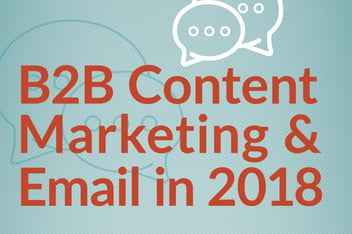3 Insights into 2023’s B2B Marketing Trends
As you settle into your 2023 content marketing routine, it can be beneficial to see what other B2B marketers are doing. Perhaps there is a new channel or tactic that you should start researching or a tip that will kick your next campaign up a notch.
Sagefrog has been watching B2B content marketing trends for a while now (16 years according to their latest report), and I appreciate seeing how they track changes over time.
A few takeaways from the current version that I think are pertinent:
-
The rush to all online (including virtual events, podcasts and webinars) that occurred when the world shut down three years ago is reversing, but now that we know how to function virtually, those channels won’t completely disappear.
-
Our three specialties (SEO, content marketing and organic social media) are here to stay.
-
The current employment market plays a role in marketing decisions, including a rebound of outsourcing.
B2B is bringing back face-to-face
Obviously, in-person events came to a screeching halt in 2020 and 2021 as the entire world navigated how to do business (safely) in a pandemic world. But Sagefrog found that while marketers were quick to adapt, now that the majority of the population feels comfortable in public again, in-person events are back.
According to surveys, 35 percent of B2B marketers are again embracing in-person trade shows and events, listing them as No. 4 in sources of quality B2B leads.
That doesn’t mean virtual events and webinars are obsolete – more than 1 in 4 are still including them in their B2B marketing mix. What it does mean is rethinking campaigns beyond the screen again. There is value in eye-to-eye, face-to-face, physical connection in the same space. Be sure your brand is ready for both IRL and virtual worlds. Those new skills picked up to reach audiences virtually can still be used to complement and supplement other channels.
Our clients have seen success with in-person events again in 2022, including Yes Health, which introduced a rebrand as part of their return to the face-to-face field last spring. Read more about that event here, along with the updated website the company launched with support from JONES.
The basics are still essential: SEO, content and social
Whether marketers are asked which tactics they implement most or which tactics are most effective, the top answer is the same: SEO.
SEO can take many different forms, from behind-the-scenes optimization that improves factors such as page loading speed to carefully crafted content that addresses the most common queries from your targeted audiences. Along with topping the “most used” and “most leads” categories in Sagefrog’s surveys, SEO and SEM was the second-highest category in terms of marketing spend for B2B marketers.
An interesting side note regarding marketing spend: Despite all of the talk of recession, nearly 2/3 of those surveyed said their marketing budgets were increasing for 2023, and another 25 percent anticipated staying the same. Marketing is an investment B2B businesses are willing to make.
Back to those basics—both content marketing and organic social media marketing were used by 43 percent of those surveyed. It’s really no surprise, as these are the engines that drive the top of the funnel especially. Content marketing by its nature feeds into effective SEO—blog posts, website copy, and email campaigns that drive traffic all factor into search engine rankings.
While they fall lower on the list of direct sources of qualified leads, they are essential to providing the brand awareness that greases the wheel for other tactics.
Curious about the full lists?
According to the B2B marketers surveyed by Sagefrog, the 10 most implemented marketing tactics for 2023 will be:
-
Search engine optimization
-
Content marketing
-
Organic social media
-
Paid social media
-
In-person tradeshows and events
-
Virtual events and webinars
-
Search engine marketing (SEM)
Top areas of marketing spend will include:
-
In-person tradeshows and events
-
Search engine marketing and optimization
-
Sales and marketing materials
-
Direct marketing
-
Content marketing
-
Social media
-
Planning and strategy
A little outsourcing can be a big help
I’ll end with a statistic that Sagefrog mentioned at the very beginning of their report: 56 percent of those surveyed outsource at least some portion of their marketing. Reasons include support for specific needs such as a product launch (27 percent) or a specific project (18 percent), while others need agency expertise (21 percent) or just more marketing resources and staffing support (11 percent). Nearly 1 in 10 said the challenge of recruiting in-house staff was the primary reason.
Regardless of why they choose to outsource marketing, the benefits of finding the right agency are significant. Which is why we offer these tips for choosing your partner when you need more expertise or resources to achieve your marketing goals: Your 8-Point Checklist to Picking a Marketing Partner.
How is your 2023 strategy shaping up? Whether you are investing additional budget into the tried and true SEO and content marketing strategies, needing to refresh your brand’s look to return to in-person events with new energy or taking on projects that are overdue, such as a website upgrade, JONES has the expertise to supplement your marketing team each step of the way.
Let’s chat about your 2023 goals and the steps necessary to meet them. Schedule a time in my calendar today.
-1.png?width=1652&height=294&name=Jones(RGB)-1.png)








.jpg?width=352&name=Adobe%20Spark%20(60).jpg)

.png?width=352&name=B2B%20Content%20Marketing%20In%202019%20And%20Beyond%20(infographic).png)

